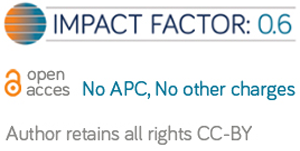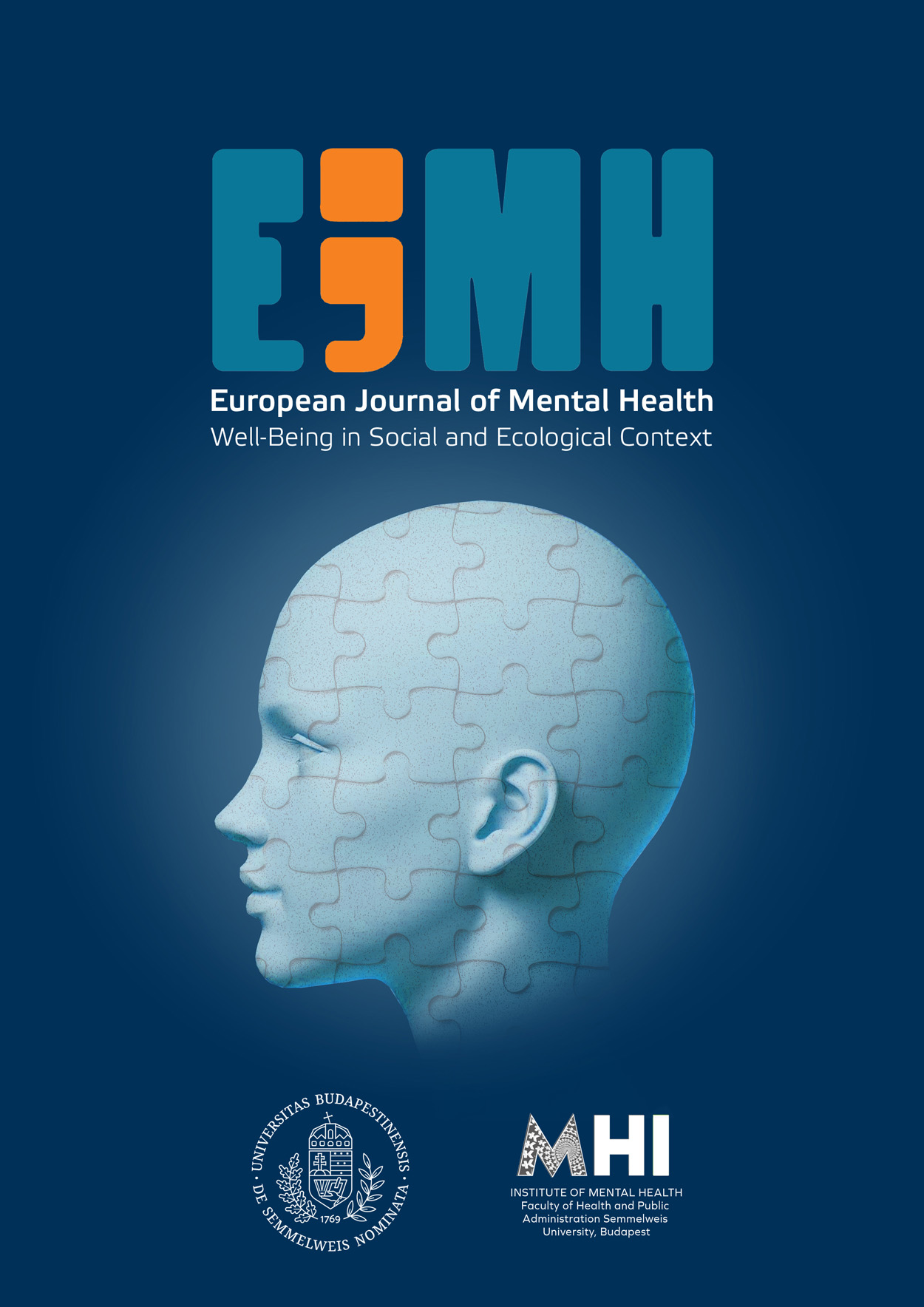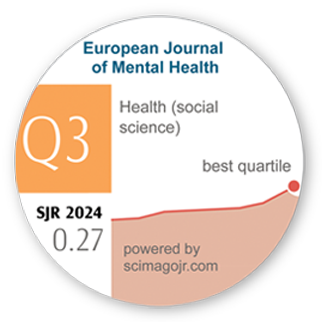Parental Burnout in Hungary - Development and psychometric evaluation of the Hungarian Parental Burnout Assessment (PBA-HUN)
DOI:
https://doi.org/10.5708/EJMH/17.2022.1.5Keywords:
parental burnout, psychometric properties, reliability, validity, COVID-19Abstract
Introduction: Parental burnout might take place when excessive demands overwhelm the parents’ resources.
Aims: To develop and validate the Hungarian version of the Parental Burnout Assessment (PBA-HUN), an instrument designed to measure parental burnout; and to determine the prevalence of parental burnout in Hungary.
Methods: Data were collected via an online survey from parents with at least one child living in the household (N = 1215; 82.6% mothers; Mage = 38.68 years; SDage = 6.27 years). Confirmatory factor analysis was used to investigate the factor structure of the PBA-HUN.
Results: The four-factor structure of the original PBA was replicated, confirming the following factors: exhaustion in one’s parental role, contrast with one’s parental role, feelings of being fed up, and emotional distancing from one’s children. A second-order model with a higher-order factor representing overall parental burnout also fit the data well. The internal consistency of both the subscale and total scores was excellent (α ≥ 0.84). Parental burnout had a moderately strong negative correlation with life satisfaction, and weak or moderate positive correlations with perceived stress, depression, vital exhaustion, and COVID-specific perceived stress supporting the construct validity of the PBA-HUN. The prevalence of parental burnout stood at 5.8% in this sample. The weak relationship between PBA-HUN scores and sociodemographic factors was also similar to those found in prior studies. Parental burnout correlated negatively with the number of hours spent sleeping and engaging in spare time activity, respectively.
Conclusions: The PBA-HUN is a reliable and valid tool to assess parental burnout in Hungary.
References
Aktan, O., Orakçi, Ş., & Durnalı, M. (2020). Investigation of the relationship between burnout, life satisfaction and quality of life in parents of children with disabilities. European Journal of Special Needs Education, 35(5), 679 – 695.
https://doi.org/10.1080/08856257.2020.1748429
Appels, A., & Mulder, P. (1988). Excess fatigue as a precursor of myocardial infarction. European Heart Journal, 9(7), 758–764.
https://doi.org/10.1093/eurheartj/9.7.758
Arikan, G., Üstündag-Budak, A. M., Akgün, E., Mikolajczak, M., & Roskam, I. (2020). Validation of the Turkish version of the Parental Burnout Assessment (PBA). New Directions for Child and Adolescent Development, 2020(174), 15–32.
https://doi.org/10.1002/cad.20375
Aunola, K., Sorkkila, M., & Tolvanen, A. (2020). Validity of the Finnish version of the Parental Burnout Assessment (PBA). Scandinavian Journal of Psychology, 61(5), 714–722.
https://doi.org/10.1111/sjop.12654
Aunola, K., Sorkkila, M., Tolvanen, A., Tassoul, A., Mikolajczak, M., & Roskam, I. (2021). Development and validation of the Brief Parental Burnout Scale (BPBS). Psychological Assessment, 33(11), 1125–1137.
https://doi.org/10.1037/pas0001064
Beck, A. T., Ward, C. H., Mendelson, M., Mock, J., & Erbaugh, J. (1961). An inventory for measuring depression. Archives of General Psychiatry, 4(6), 561–571.
https://doi.org/10.1001/archpsyc.1961.01710120031004
Beheshtipour, N., Nasirpour, P., Yektatalab, S., Karimi, M., & Zare N. (2016). The effect of educational-spiritual intervention on the burnout of the parents of school age children with cancer: A randomized controlled clinical trial. International Journal of Community Based Nursing and Midwifery, 4(1), 90–97.
Bellingrath, S., Weigl, T., & Kudielka, B. M. (2008). Cortisol dysregulation in school teachers in relation to burnout, vital exhaustion, and effort-reward-imbalance. Biological Psychology, 78(1), 104–113.
https://doi.org/10.1016/j.biopsycho.2008.01.006
Brianda, M. E., Roskam, I., Gross, J. J., Franssen, A., Kapala, F., Gérard, F., & Mikolajczak M. (2020). Treating parental burnout: Impact of two treatment modalities on burnout symptoms, emotions, hair cortisol, and parental neglect and violence. Psychotherapy and Psychosomatics, 89, 330–332.
https://doi.org/10.1159/000506354
Cohen, S., Kamarck, T., & Mermelstein, R. (1983). A global measure of perceived stress. Journal of Health and Social Behavior, 24(4), 385–396.
https://doi.org/10.2307/2136404
Diener, E., Emmons, R. A., Larsen, R. J., & Griffin, S. (1985). The Satisfaction with Life Scale. Journal of Personality Assessment, 49(1), 71–75. https://doi.org/10.1207/s15327752jpa4901_13
Dupcsik, Cs., & Tóth, O. (2014). Family systems and family values in twenty-first-century Hungary. In Zs. Rajkai, (Ed.), Family and Social Change in Socialist and Post-Socialist Societies, (pp. 210–249). Brill.
Falkné Bánó, K. (2014). Identifying Hungarian cultural characteristics in Europe’s cultural diversity in the 21st century: a controversial issue. In K. Soltb (Ed.), Alkalmazott tudományok I. fóruma: Konferenciakötet. (pp. 17–28). Budapesti Gazdasági Főiskola.
Forero, C. G., Maydeu-Olivares, A., & Gallardo-Pujol, D. (2009). Factor analysis with ordinal indicators: A Monte Carlo study comparing DWLS and ULS estimation. Structural Equation Modeling 16(4), 625–641.
https://doi.org/10.1080/10705510903203573
Frestad, D. & Prescott, E. (2017). Vital Exhaustion and Coronary Heart Disease Risk: A Systematic Review and Meta-Analysis. Psychosomatic Medicine, 79(3), 260–272.
https://doi.org/10.1097/PSY.0000000000000423
Furutani, K., Kawamoto, T., Alimardani, M., & Nakashima, K. (2020). Exhausted parents in Japan: Preliminary validation of the Japanese version of the Parental Burnout Assessment. New Directions for Child and Adolescent Development, 2020(174), 33–49.
https://doi.org/10.1002/cad.20371
Gannagé, M., Besson, E., Harfouche, J., Roskam, I., & Mikolajczak, M. (2020). Parental burnout in Lebanon: Validation psychometric properties of the Lebanese Arabic Version of the Parental Burnout Assessment (PBA). New Directions in Child and Adolescent Development, 2020(174), 51–65.
https://doi.org/10.1002/cad.20383
Hamvai, Cs., Fáber, Á., & Konkolÿ Thege, B. (2021). Az Észlelt Stressz Kérdőív járványspecifikus verziójának validálása [Validation of the Pandemic-specific version of the Perceived Stress Scale]. Orvosi Hetilap, 162(35), 1391–1396.
https://doi.org/10.1556/650.2021.32207
Hu, L.-T., & Bentler, P. M. (1999). Cutoff criteria for fit indexes in covariance structure analysis: Conventional criteria versus new alternatives. Structural Equation Modeling: A Multidisciplinary Journal, 6(1), 1–55.
https://doi.org/10.1080/10705519909540118
Kawamoto, T., Furutani, K., & Alimardani, M. (2018). Preliminary validation of Japanese version of the Parental Burnout Inventory and its Relationship with perfectionism. Frontiers in Psychology, 9, 970.
https://doi.org/10.3389/fpsyg.2018.00970
Kopp, M. S., Falger, P. R., Appels, A., & Szedmák S. (1998). Depressive symptomatology and vital exhaustion are differentially related to behavioral risk factors for coronary artery disease. Psychosomatic Medicine, 60(6), 752–758.
https://doi.org/10.1097/00006842-199811000-00018
Kopp, M. S., Skrabski, Á., & Szedmák, S. (1995). Socioeconomic factors, severity of depressive symptomatology and sickness absence rate in the Hungarian population. Journal of Psychosomatic Research, 39(8), 1019–1029.
https://doi.org/10.1016/0022-3999(95)00513-7
Lebert-Charron, A., Dorard, G., Boujut, E., & Wendland, J. (2018). Maternal burnout syndrome: Contextual and psychological associated factors. Frontiers in Psychology, 9, 885.
https://doi.org/10.3389/fpsyg.2018.00885
Le Vigouroux, S., Lebert-Charron, A., Wendland, R., Boujut, E., Scola, C., & Dorard, G. (in press). COVID-19 and parental burnout: Parents confined but not more exhausted. Journal of Family Issues.
https://doi.org/10.1177/0192513X211030038
Li, C.-H. (2016). The performance of ML, DWLS, and ULS estimation with robust corrections in structural equation models with ordinal variables. Psychological Methods, 21(3), 369–387.
https://doi.org/10.1037/met0000093
Lindström, C., Aman, J. & Norberg A. L. (2011). Parental burnout in relation to sociodemographic, psychosocial and personality factors as well as disease duration and glycaemic control in children with Type 1 diabetes mellitus. Acta Paediatrica 100(7), 1011–1017.
https://doi.org/10.1111/j.1651-2227.2011.02198.x
Martos, T., Sallay, V., Désfalvi, J., Szabó, T., & Ittzés, A. (2014). Az Élettel való Elégedettség Skála magyar változatának (SWLS-H) pszichometriai jellemzői [Psychometric characteristics of the Hungarian version of the Satisfaction with Life Scale (SWLS-H)]. Mentálhigiéné és Pszichoszomatika, 15(3), 289—303.
https://doi.org/10.1556/mental.15.2014.3.9
Maslach, C., & Jackson, S. E. (1981). The measurement of experienced burnout. Journal of Organizational Behavior, 2(2), 99–113.
https://doi.org/10.1002/job.4030020205
Matias, M., Aguiar, J., César, F., Braz, A. C., Barham, E. J., Leme, V., Elias, L., Gaspar, M. F., Mikolajczak, M., Roskam, I., & Fontaine, A. M. (2020). The Brazilian-Portuguese version of the Parental Burnout Assessment: Transcultural adaptation and initial validity evidence. New Directions for Child and Adolescent Development, 2020(174), 67–83.
https://doi.org/10.1002/cad.20374
Mikolajczak M., Gross J. J., & Roskam I. (2019). Parental Burnout: What is it, and why does it matter? Clinical Psychological Science, 7(6), 1319–1329.
https://doi.org/10.1177/2167702619858430
Mikolajczak M., Gross J. J., & Roskam I. (2021). Beyond job burnout: Parental burnout! Trends in Cognitive Science 25(5), 333–336.
https://doi.org/10.1016/j.tics.2021.01.012
Mikolajczak, M., & Roskam, I. (2018). A theoretical and clinical framework for parental burnout: The balance between risks and resources (BR2). Frontiers in Psychology, 9, 886.
https://doi.org/10.3389/fpsyg.2018.00886
Mikolajczak M., & Roskam I. (2020). Parental burnout: Moving the focus from children to parents. New Directions for Child and Adolescent Development, 2020(174), 7–13.
https://doi.org/10.1002/cad.20376
Mîndrilă, D. (2010). Maximum likelihood (ML) and diagonally weighted least squares (DWLS) estimation procedures: A comparison of estimation bias with ordinal and multivariate non-normal data. International Journal of Digital Society (IJDS), 1(1), 60–66.
https://doi.org/10.20533/ijds.2040.2570.2010.0010
Mousavi, S. F., Mikolajczak, M., & Roskam, I. (2020). Parental burnout in Iran: Psychometric properties of the Persian (Farsi) version of the Parental Burnout Assessment (PBA). New Directions for Child and Adolescent Development, 220(174), 85–100
https://doi.org/10.1002/cad.20369
Nomaguchi, K. M., & Milkie, M. A. (2003). Costs and rewards of children: The effects of becoming a parent on adults’ lives. Journal of Marriage and Family, 65(2), 356–374.
https://doi.org/10.1111/j.1741-3737.2003.00356.x
Norberg, A. L. (2007). Burnout in mothers and fathers of children surviving brain tumour. Journal of Clinical. Psychology in Medical Settings 14, 130–137.
https://doi.org/10.1007/s10880-007-9063-x
Pavot, W., & Diener, E. (2008). The Satisfaction With Life Scale and the emerging construct of life satisfaction. The Journal of Positive Psychology, 3(2), 137–152.
https://doi.org/10.1080/17439760701756946
Pedrozo-Pupo, J. C., Pedrozo-Cortés, M. J., & Campo-Arias, A. (2020). Perceived stress associated with COVID-19 epidemic in Colombia: An online survey. Cadernos de Saude Publica, 36(5).
https://doi.org/10.1590/0102-311x00090520
Pelsma, D. M., Roland, B., Tollefson, N., & Wigington, H. (1989). Parent burnout: Validation of the Maslach Burnout Inventory with a sample of mothers. Measurement and Evaluation in Counseling and Development, 22(2), 81–87.
https://doi.org/10.1080/07481756.1989.12022915
Prikhidko, A., Long, H., & Wheaton, M. G. (2020). The effect of concerns about COVID-19 on anxiety, stress, parental burnout, and emotion regulation: The role of susceptibility to digital emotion contagion. Frontiers in Public Health, 8, 567250.
https://doi.org/10.3389/fpubh.2020.567250
Prime, H., Wade, M., & Browne, D. T. (2020). Risk and resilience in family well-being during the COVID-19 pandemic. American Psychologist, 75(5), 631–643.
http://dx.doi.org/10.1037/amp0000660
Roskam, I., Aguiar, J., Akgun, E., Arikan, G., Artavia, M., Avalosse, H., Aunola, K., Bader, M., Bahati, C., Barham, E. J., Besson, E., Beyers, W., Boujut, E., Brianda, M. E., BrytekMatera, A., Carbonneau, N., César, F., Chen, BB., ... Mikolajczak, M. (International Investigation of Parental Burnout Consortium) (2021). Parental burnout around the globe: A 42-country study. Affective Science, 2, 58–79.
https://doi.org/10.1007/s42761-020-00028-4
Roskam, I., Brianda, M.-E., & Mikolajczak, M. (2018). A step forward in the conceptualization and measurement of parental burnout: The Parental Burnout Assessment (PBA). Frontiers in Psychology, 9, 758.
https://doi.org/10.3389/fpsyg.2018.00758
Roskam, I., Raes, M.-E., & Mikolajczak, M. (2017). Exhausted parents: Development and preliminary validation of the Parental Burnout Inventory. Frontiers in Psychology, 8, 163.
https://doi.org/10.3389/fpsyg.2017.00163
Rosseel, Y. (2012). lavaan: An R package for Structural Equation Modeling. Journal of Statistical Software, 48(2), 1–36.
https://doi.org/10.18637/jss.v048.i02
Rózsa, S., Szádóczky, E., & Füredi, J. (2001). A Beck Depresszió Kérdőív rövidített változatának jellemzői a hazai mintán [Characteristics of the shortened version of the Beck Depression Questionnaire in a national sample]. Psychiatria Hungarica, 16(4), 379–397.
Sarrionandia, A., & Aliri, J. (2021) Initial validation of the Basque version of the Parental Burnout Assessment (B‐PBA). Scandinavian Journal of Psychology, 62(3), 348–354.
http://doi.org/10.1111/sjop.12707
Sodi, T., Kpassagou, L. B., Hatta, O., Ndayizigiye, A., Ndayipfukamiye, J.-M., Tenkué, J. N., Bahati, C., & Sezibera, V. (2020). Parenting and parental burnout in Africa. New Directions for Child and Adolescent Development, 2020(174), 101–117.
https://doi.org/10.1002/cad.20386
Sorkkila, M., & Aunola, K. (2020). Risk factors for parental burnout among Finnish parents: The role of socially prescribed perfectionism. Journal of Child and Family Studies, 29, 648–659.
https://doi.org/10.1007/s10826-019-01607-1
Stănculescu, E., Roskam, I., Mikolajczak, M., Muntean, A., & Gurza, A. (2020). Parental burnout in Romania: Validity of the Romanian version of the parental burnout assessment (PBA-RO). New Directions for Child and Adolescent Development, 2020(174), 119–136.
https://doi.org/10.1002/cad.20384
Stauder, A., & Konkolÿ Thege, B. (2006). Az Észlelt Stressz Kérdőív (PSS) magyar verziójának jellemzői [Feautures of the Hungarian version of the Perceived Stress Questionnaire (PSS)]. Mentálhigiéné és Pszichoszomatika, 7(3), 203–216.
https://doi.org/10.1556/Mental.7.2006.3.4
Szczygieł, D., Sekulowicz, M., Kwiatkowski, P., Roskam, I., & Mikolajczak, M. (2020). Validation of the Polish version of the Parental Burnout Assessment (PBA). New Directions for Child and Adolescent Development, 2020(174), 137–158.
https://doi.org/10.1002/cad.20385
Takács, J. (2020). How involved are fathers in Hungary? Exploring caring masculinities in a post-socialist context. Families, Relationships, and Societies, 9(3), 487–502.
https://doi.org/10.1332/204674319X15592179267974
Umberson, D., Pudrovska, T., & Reczek, C. (2010). Parenthood, childlessness, and well-being: A life course perspective. Journal of Marriage and Family, 72(3), 612–629.
https://doi.org/10.1111/j.1741-3737.2010.00721.x






